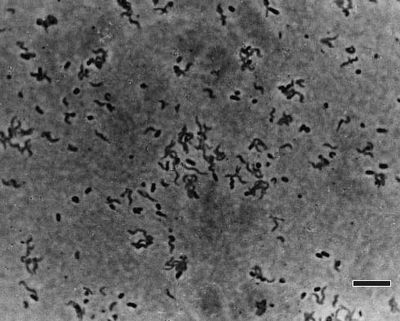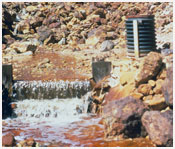Leptospirillum
A Microbial Biorealm page on the genus Leptospirillum

Classification
Higher order taxa:
Bacteria; Nitrospirae; Nitrospira (class); Nitrospirales; Nitrospiraceae
Species:
Leptospirillum ferriphilum, Leptospirillum ferrooxidans, Leptospirillum sp.
Description and Significance
Leptospirillum is a genus of iron-oxidizing bacteria which play an important role in industrial bioleaching (the conversion of metals to a soluble form) and biooxidation (the extraction of metals). They are obligate aerobes (require oxygen gas). Leptospirilla have been found to be the primary iron-oxidizers in industrial continuous-flow biooxidation tanks. The reason for this bacteria's domination in biooxidation is most likely the fact that the high ferric-ferrous iron ratio inhibits all but species of Leptospirillum. Leptospirilla are also important contributors to the acid mine drainage process; these combine to make Leptospirilla more important players in the acid mine processes than previously thought.
Genome Structure
Studies on the genetics of bacterial components of acid mining systems have revealed Leptospirillum's prominence in several areas of the process, leading to new revelations about the bacteria's role in the industry. Sequencing of certain isolates' 16S rRNA has demonstrated the existence of new species of Leptospirilla. There have also been several plasmid sequences done to Leptospirillum ferrooxidans. The first one, called Leptospirillum ferrooxidans plasmid p49879. 1, was 28878 bp long, and the second, called Leptospirillum ferrooxidans plasmid p49879. 2, was 28012 bp long.
Cell Structure and Metabolism
Leptospirillum's cells are Gram-negative and spiral-shaped, 0.3-0.5 microns wide and 0.9-3.0 microns in length. Metabolically they are strictly chemolithoautotrophic, fixing carbon using ferrous iron as their electron donor and oxygen as the electron acceptor. Because of this, they are some of the most metabolically-restricted organisms known. Generally Leptospirillum species have few distinct physiological characteristics which make them identifiable; most researchers use molecular analyses to distinguish them from other bacteria.
Ecology
Leptospirillum may contribute to some forms of pollution, primarily in acid mine drainage. One such area where this has been an issue is Iron Mountain in Northern California, home of the largest amount of toxic metals in the United States. Rivers and streams which run off of the mountain contain highly acidic waters. The organisms of Leptospirillum are found deep underground in the mines, enveloped in a pink biofilm which floats on the surface of water flowing in the mine. They are important industrially in terms of their role in bioleaching, extracting metals from minerals. Until recently there were few ecological studies performed involving this genus, revealing that one of every two oxidizers of ferrous iron were species of Leptospirilla. Therefore, while their part in the bioleaching process is evident, the distribution of this and similar bacteria remains questionable.
References
Ruder, Kate. Iron Mountain's Champion Extremophiles. Genome News Network, February 6 2004.


